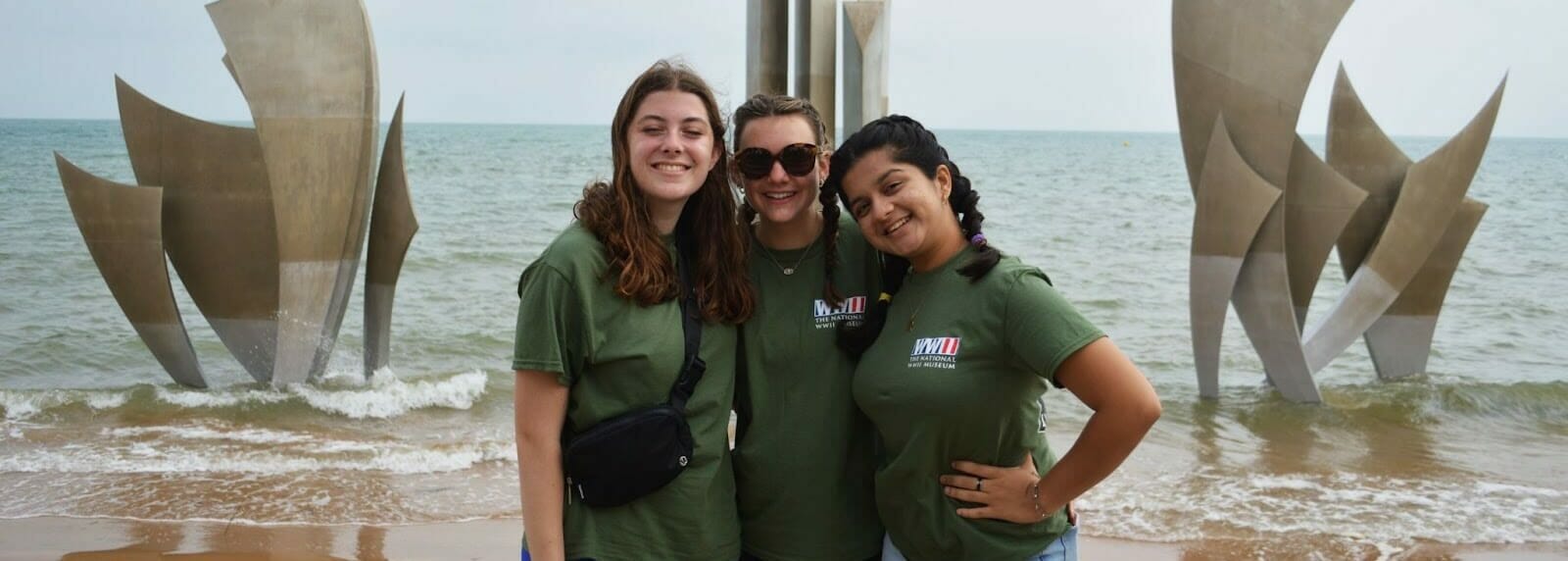“War is Always People” – Normandy Academy Fellows Explain D-Day to Freshmen
On Thursday, October 27, 2022, our three Normandy Academy fellows, Aanya Tiwari ’23, Chloe Davis ’24, and Abby Wyckoff ’24, presented to ninth-grade history students about their unique learning experience this past summer in New Orleans, Louisiana and Normandy, France. The National World War II Museum’s Normandy Academy is a 12-day trip that challenges students to learn from the choices made before and during the historic D-Day landings. Through the generosity of Edward T. Baur ’64, these students were selected as the Pete Wilson ’51 Fellows for Normandy Academy and received full scholarships (including flights, tuition, meals, etc.) to participate in the Academy. Upon their return, the fellows shared what they saw and learned with the ninth-grade class as part of their Post-1900 World Unit on World War II. Below are Aanya, Chloe, and Abby’s remarks from their presentation.
“The eyes of the world are upon you. The hopes and prayers of liberty-loving people everywhere march with you.” In the words of Eisenhower, those involved in D-Day carried the burden of humanity on their shoulders. All these individuals are the reason we are here today. We now take you through the story of how we got here. This is the story of D-Day and how we experienced D-Day through our trip this past summer.
Let’s get right into it. D-Day. Operation Overlord. Normandy Invasion. The Turning Point. All of these names refer to the wide-scale, critically-planned, amphibious Allied operation that was pivotal in altering the fate of World War II. The same operation tilted the war in our favor by liberating Northwest Europe from Nazi occupation.
Beginning on June 6, 1944, over 150,000 American, British and Canadian forces landed on five beaches along the heavily fortified coast of France’s Normandy region. This invasion encompassed multiple military assaults that required extensive planning in order to achieve success.
However, this success is often considered to be mere luck. Pre-recorded broadcasts were saved, solemnly informing the American public of the mission’s failure. Weather, water conditions, and functionality of equipment could all be unfavorable.
June 6 could have gone in a multitude of ways. However, the success of D-Day came from the unparalleled bravery of Allied soldiers. This is not only written in history but was a recurring theme we take away from the trip. Each person involved treated this operation with such dedication, almost like they were taking on D-Day by themselves. Aside from soldiers, years around the clock were spent planning this operation. The Normandy Coast that was attacked included five different beachfronts codenamed Utah, Omaha, Gold, Juno, and Sword.
The goal was to free Normandy from German occupation, ultimately using the region as a launch point to recapture France. Let’s break down how they did this.
The first part of the attack was airborne. Early in the night of June 5, the Allies launched planes dragging along fighting Horsa gliders— wooden plane-like aircraft with no engines that were intended to transport equipment and infantry 6-10 miles behind German lines. These gliders were released right before the coast so that the Germans would not be alerted of their presence. Because they had no engines, the gliders were quiet and flew similar to paper airplanes with the pilots having little to no control.
Many of the gliders were destroyed upon landing, resulting in casualties and loss. However, the initial landing was an overall success, and the infantrymen were able to set up light beacons to direct and guide the incoming paratroopers. The infantry combined forces with the paratroopers and was able to cut off German forces, and they would later help join the beaches. One force of gliders, part of the 6th Airborne division led by Major John Howard, was able to surprise the Germans and covertly capture the Caen Canal and Orne River Bridges— the most famous now known as Pegasus Bridge.
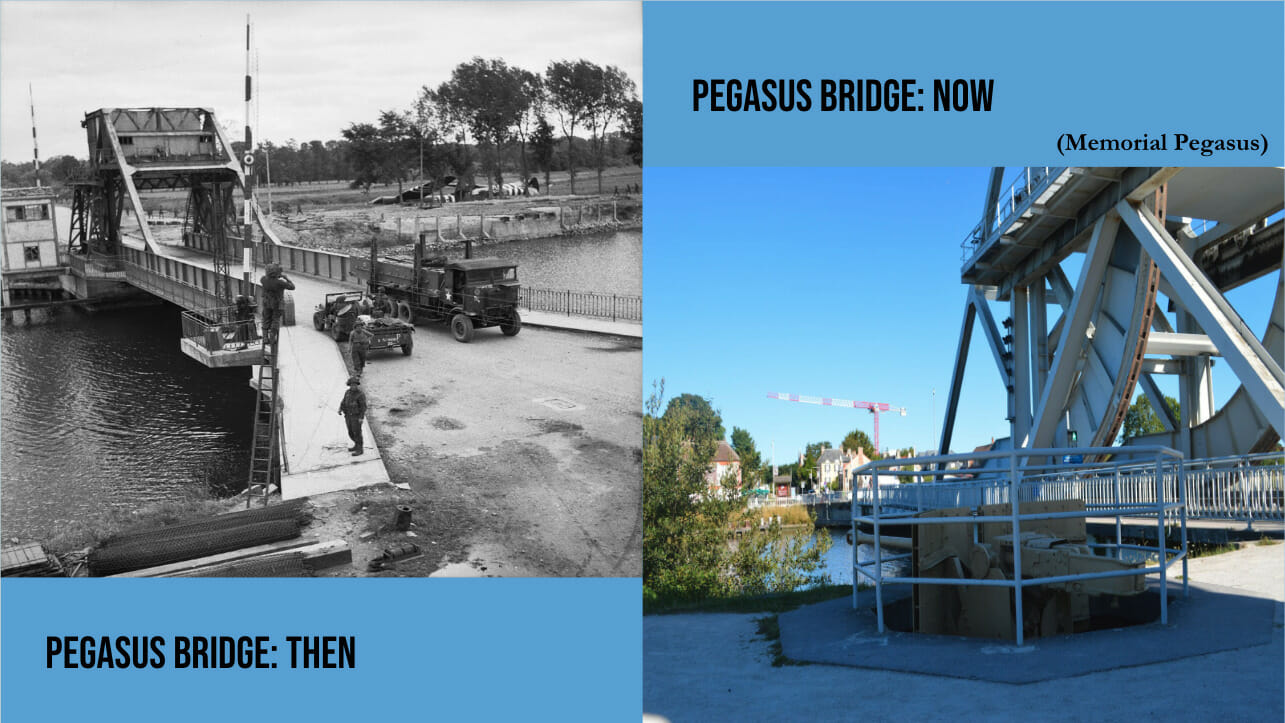
Above is a comparison of Pegasus Bridge at the time of the landings [left] and at present day [right]. The bridge on the left was the original bridge, built in 1934. This was entirely destroyed so they reconstructed the same bridge at the same site in Normandy in 1994 as you can see on the right. However, the original bridge is still preserved and you can walk on it and actually see bullet holes and marks left by the conflict.
There is also a memorial decked with poppies that has been established in honor of Major John Howard. He and his men were actually able to capture Pegasus Bridge within 10 minutes because the German soldiers were sleeping down in the bunker and the two on patrol who heard the sound thought it was an Allied plane that had gotten shot down, and that the pilot was most likely dead. This allowed for a surprise attack, resulting in only two Allied deaths.
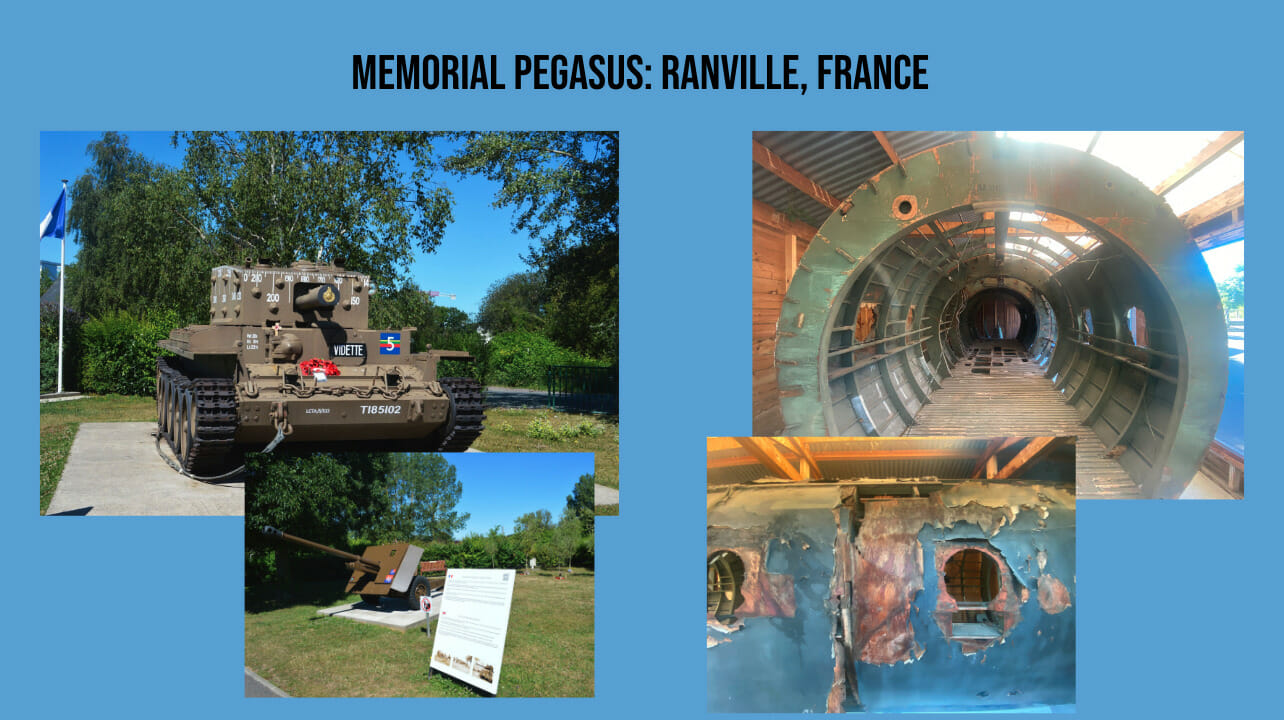
Despite the initial capture of the river, the battle for control of the town would continue and soon became very violent. The museum and memorial are dedicated to the 6th Airborne Division because of their bravery, and they contain accurately reconstructed models of warfare technology like the Allied Anti-Tank shown on the left. On the right are images from the actual Horsa glider that landed near the river. This is just one example of a lesser-known operation that was extremely influential and necessary for Allied success on D-Day.
By 6:00 a.m., the Allies successfully made their mark and the fighting continued. Then, around 30 minutes later, we see the landings across the five Normandy beachfronts wherein each victory was essential in capturing coasts and moving in on Germans. American forces tackled Utah and Omaha while British and Canadian forces tackled Juno, Sword, and Gold. These beaches along the coast were selected because they were weakly defended corners of the German Atlantic Wall. Besides this, landings in Normandy were reliable because Normandy is close to the Isle of Wight which houses several naval ports and railways of Southern England. This meant that troops and supplies could move comfortably.
These beaches were also able to be used due to the tactical advantages of the Allied army. For example, Higgins Boats were the landing craft used extensively by the Allies during the invasion. They originated from Higgins Industries in NOLA and were used in every American amphibious operation. Why were these important? Well, they eliminated the need for a harbor and ultimately made an amphibious invasion, specifically D-Day, possible. With Higgins Boats, the Allies were able to bring masses of men and equipment to the shore quickly and efficiently. The ramp at the front allowed for simple and fast unloading, and the bow of the ship worked to keep the boat from getting stuck in the sand. Without these boats, the Allies would have struggled to get their forces ashore, especially under constant fire.
However, even with these developments, the operation wasn’t perfect. While all the landings were extremely significant, the fight for Omaha soon became the most infamous and the most memorable.
Why “Bloody Omaha?” Well, the infamous Omaha Beach saw the most casualties, predominantly American compared to the other landings. Most soldiers referred to Omaha as a “horrific killing zone.”
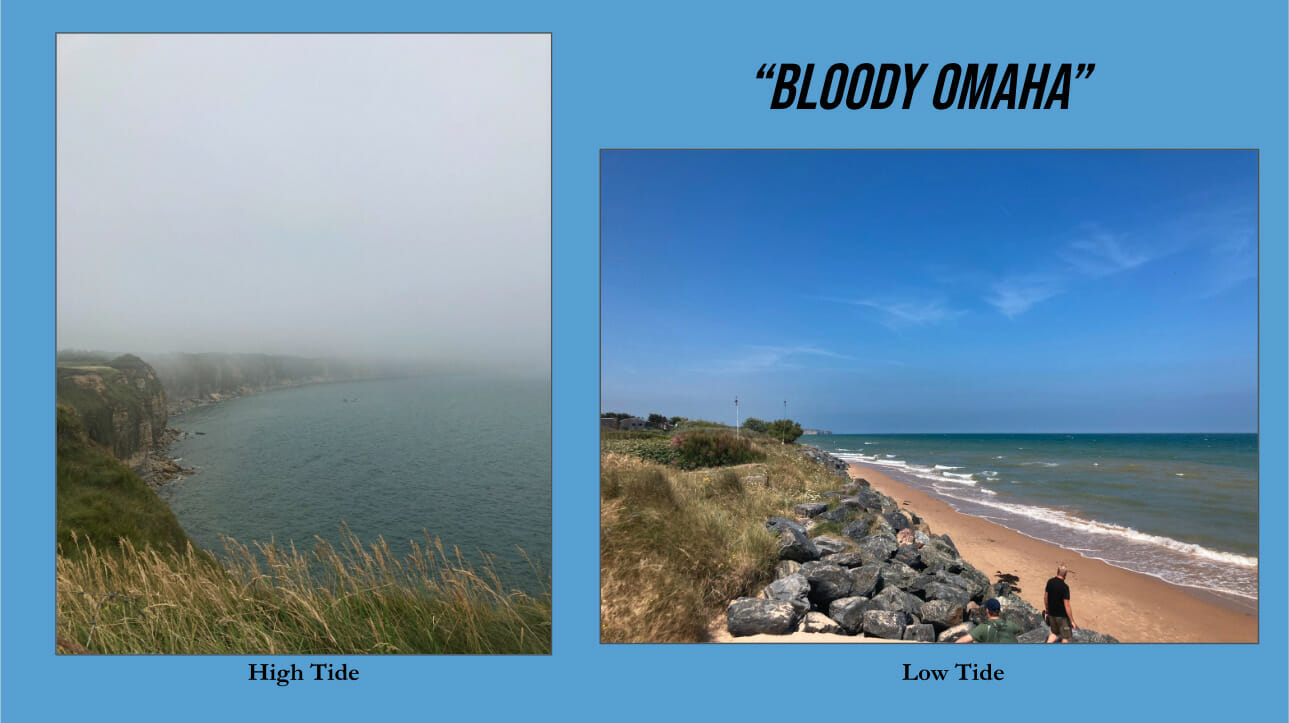
So, what made Omaha Beach have such a high casualty rate with 2,400 dead? There are multiple reasons. Firstly, as you can see, we have images of Omaha Beach across high and low tide. As part of our experience, we visited Omaha twice in order to observe this front across both tides. On the left, we see low tide. We got to walk across the coast and swim in low tide Omaha Beach. It was clear that the water was rather tame at the time. This was dramatically different from Omaha Beach in high tide where we overlooked the waters through a bridge and Pointe Du Hoc. High tide was fast, powerful, and intimidating to experience. These tides are important because a rising tide or, rather, a high tide was able to drive Allied forces to the coast effectively. Now, this was definitely a risk.
However, this risk was ultimately successful due to the fact that the majority of troops made it to the coast. That said, the waters and the beach as a whole were heavily mined, and there were over 13 resistance nets underwater. Off the bat, soldiers and ships were immediately drowned. Casualties piled due to fire exchange from across the beach, the extensive German trench system, and scattered armed battalions. The Allied troops had to make their way through the coast and past the German forces in order to recapture coastal villages like Vierville, Saint-Laurent, and Colleville and continue to move in. Moving in meant getting past German gunners’ deadly firing that constantly left soldiers and ships dropping like dominoes. Americans were faced with a seemingly impossible task: recapturing a German position with nowhere to seek refuge and no sense of security, especially until troops reached the seawall. It was truly a bloodbath, and sometimes the first landings were referred to as “suicide waves.”
We’d be here forever if we were to go through all the minor fronts of Omaha beach so we’ll narrow in on one, pivotal area of Omaha known as Pointe Du Hoc. It is an ominous piece of land jutting into the English Channel and simply a few miles away from the main area of Omaha Beach. This land is at a significant elevation where landings around Pointe Du Hoc demanded US Army Rangers scale the massive, 100-foot cliffs to seize German artillery that could potentially fire at the close-range beaches. Imagine this: hiking up cliffs in drenched armor and weaponry that easily weighs 40-50 pounds along with the added weight of water and the strong winds blowing away from the cliffs. This is what these rangers overcame. It is beyond commendable that they pulled such a feat for the capture of Pointe Du Hoc was key in the overall success of Omaha landings and therefore D-Day from a holistic perspective.
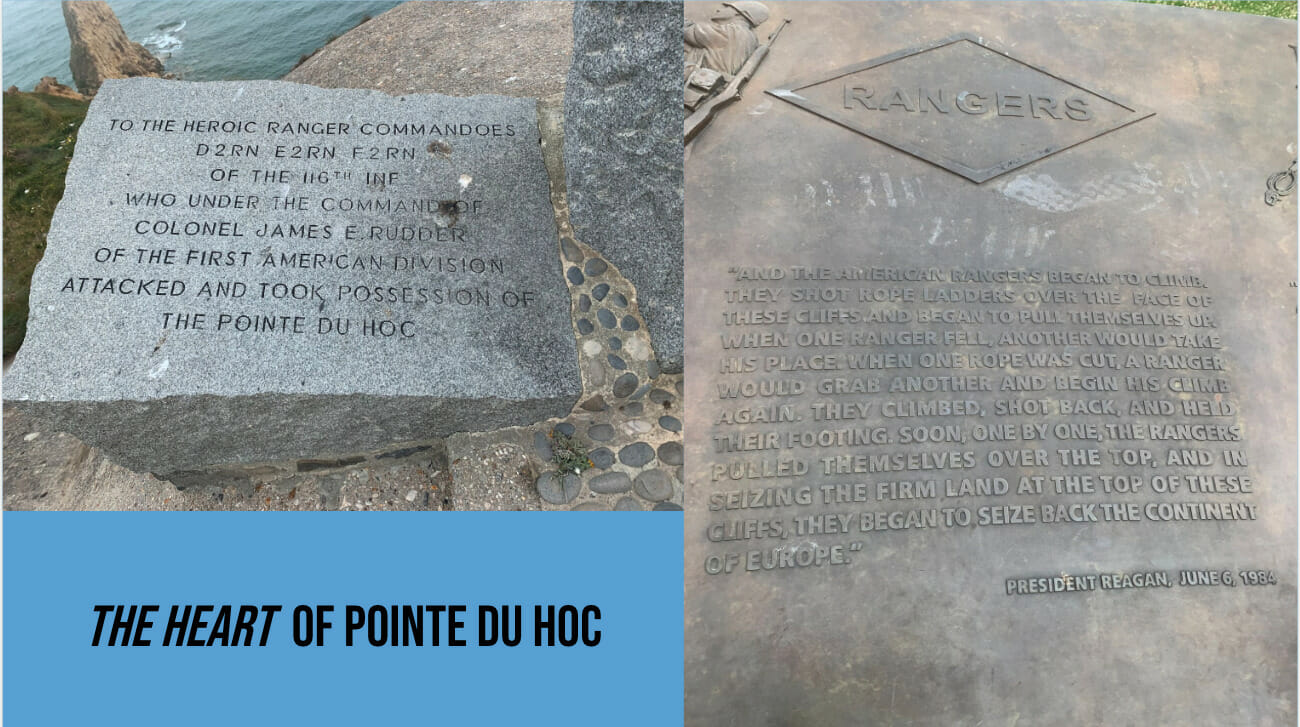
When it really comes down to it, Pointe Du Hoc was driven by the people that carried out such an operation. Naturally, these forces could have given up and gone home considering the level and extent of difficulty at Omaha Beach, yet they persisted no matter what, echoing this patriotic spirit for their own nations and for the collective body of Allies. As shown here, these are engraved stones from Pointe Du Hoc. On the right, we commemorate those noble rangers and commanders who were responsible for taking charge of Pointe Du Hoc and its recapture. As for the left, there lies a quote by Ronald Reagan wherein he sends a message that as these rangers never failed to give and kept going, at each step we were regaining the continent of Europe. All of it is truly moving.
As successful as this all may sound, it was only possible due to the masterful deception involved in any and all operations. A critical part of Operation Overlord was deception to prepare for this intricate offensive. Across the English Channel, Pas de Calais was the closest point in France to launch an attack. However, this city was heavily fortified and the Atlantic wall was extremely strong. Regardless, the Allies deceived the Germans into thinking this was their point of entry into France.
After mathematician Alan Turing cracked the German Enigma machine, which encrypted classified German messages, the Allies had the upper hand in deciphering German messages and getting intelligence that allowed the Allies to see what the Germans knew and were buying into, which was crucial because the goal of the Allies was to draw the Germans away from Normandy. As preserved at the National World War II museum, you can see the image of the Enigma machine.
Another example of German deception was paradummies or “Ruperts.” These were used in Operation Titanic as decoys on June 6th to fake a massive airborne landing, confusing and overwhelming the Germans while drawing them away from the real landing zones. Many were also equipped with recording devices that simulated gunfire and exploding mortar rounds to enhance realism. There were many other types of deception, but the intricacy of this operation, named Bodyguard, was extreme and inarguably critical for the Allies’ success.
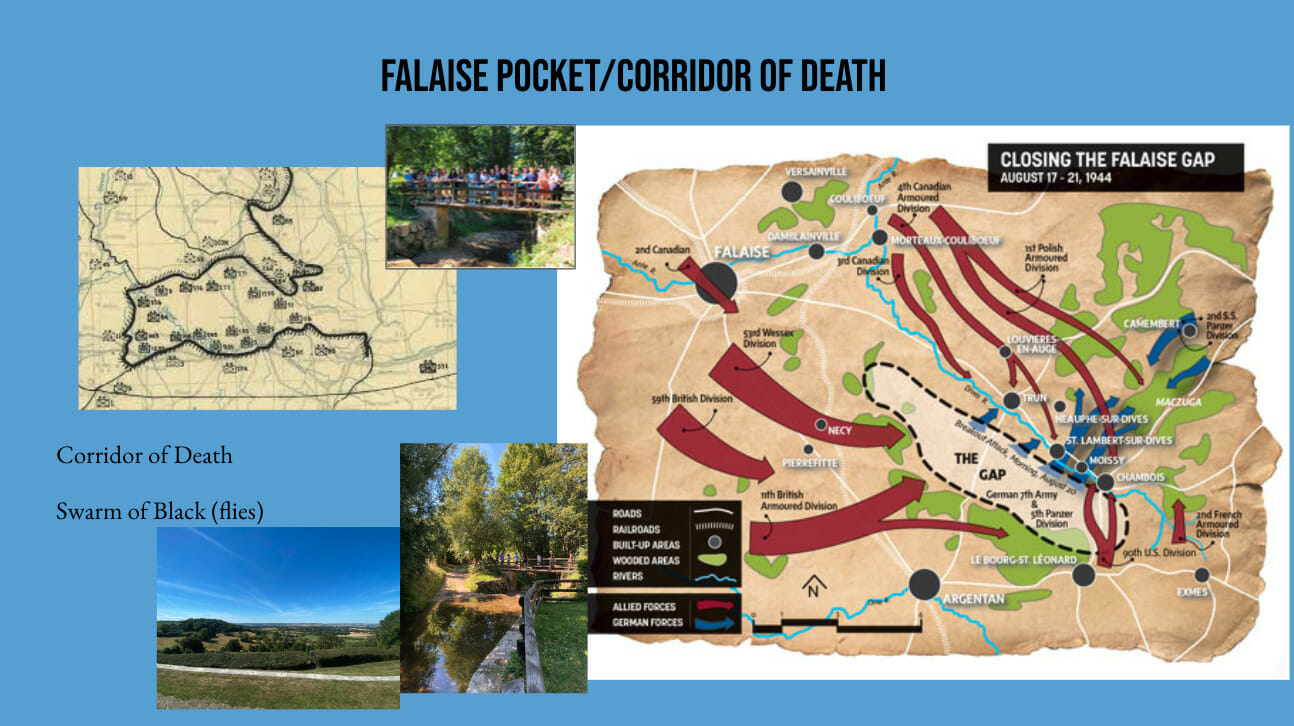
So what role did D-Day have in regaining control of France? Well, the Allies had a specific strategy. Essentially British and Canadian troops were to attack around Caen. Then, American bombers carpet-bombed the western end of the German lines around Saint-Lo. The Americans then pushed into the resulting gap. The German forces had no option but to retreat through a singular opening. Essentially, the Allied forces encircled the Germans, many of whom tried to escape eastward. While some were able to, thousands of Germans were captured by the Allies or killed in what is known as the “Corridor of Death” as pictured above. The sight was gruesome: heavy machinery couldn’t pass, horses and men were dead—some hanging on hedgerows, the stench permeated the air with swarms of flies, creating black masses. However, with the collapse of the German position, the Allies were able to control the Normandy region and swiftly recapture Paris. The Allies were then able to begin their final campaign to control France.
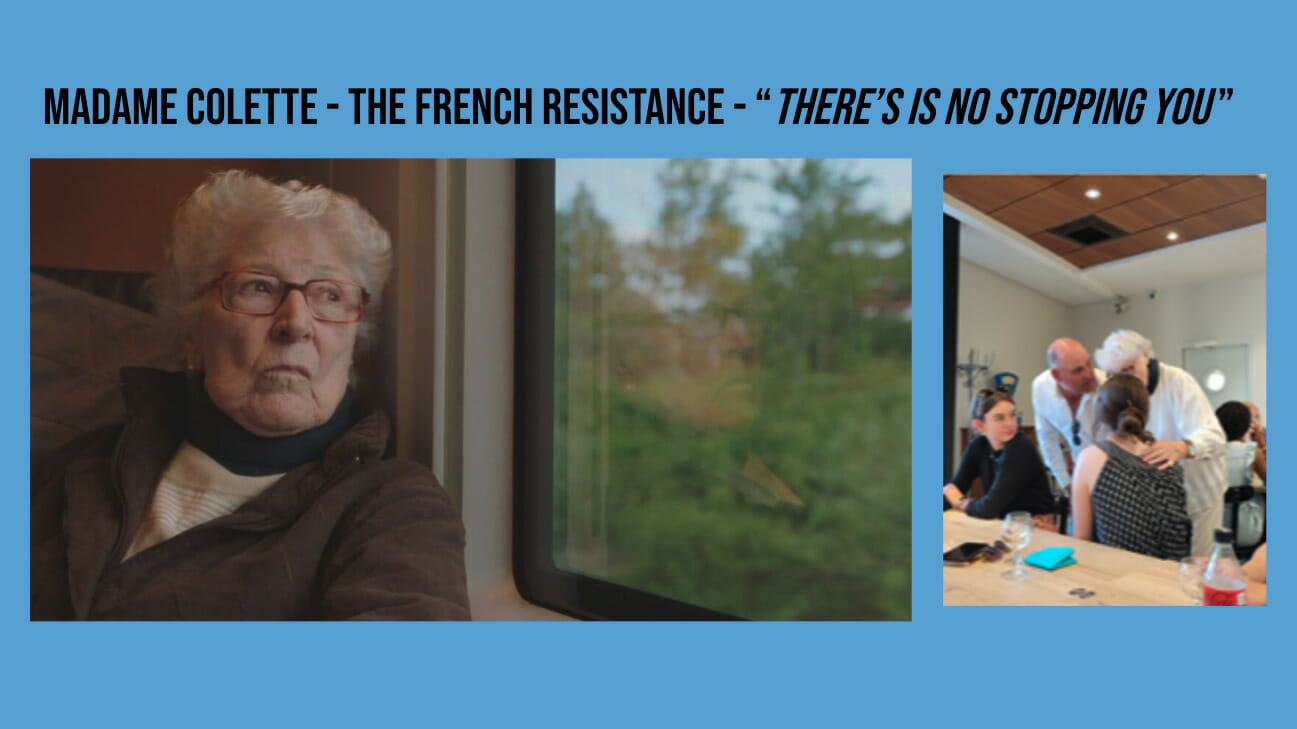
We were extremely lucky as we received the opportunity to chat with Madame Colette, an active member of the French resistance. The French Resistance was a collection of organizations that fought the Nazi occupation of France during WWII.
Ninety-year-old Madame Colette Marin Catherine or, rather, Madame Colette left us speechless with her experiences. Each and everyone one of her family members was a member of the French Resistance, carrying out different duties. At the time of war, she was only 13 years old, and she contributed to the efforts by pulling pranks on Nazi German officers. She would put anti-German quotes and jokes in the pockets of German coats whilst they dined at restaurants and would jam their automobile engines by clogging them with sugar. It was refreshing to hear her lighthearted stories like these for they brought out sheer innocence and a sense of youth amidst the war. As for the rest of her family, they would collect any weapons found, distribute false information, and track information and intel. Moving forward, her job was to keep track of German vehicles and their movements, so she would pretend to do her homework, but actually, she would be keeping record of the regimen and number of German vehicles she spotted. They did this because they wanted to know the type and supply of tanks, artillery, machinery, airplanes, ships, and more that were coming into the territory. Clearly, her entire family was at risk because they did all this work in the shadows and had to strictly adhere to that protocol. They would be doomed the minute their family name would reach the Gestapo watch list for Colette’s family would be on their radar. Naturally, they kept up codenames for one another, expressed complete denial, kept discussion of tasks to the bare minimum, and always answered to the satisfaction of Nazi officers.
Well, we could go on and on about Madame Colette and her invaluable insight. To all of us, she became our new hero. She embraced her life and lived it to the fullest given the circumstances. She told all of us that it was never too late to help in making a difference or even be the reason for a difference. Moreover, she empowered all the girls on our trip and of the world by repeatedly enforcing that a woman could do anything and everything just as well as a man. She embodies the nature of a true Allied fighter with her limitless dedication, drive, and determination. We really were facing history before ourselves.
We visited multiple cemeteries throughout the Normandy region, but two of the most significant and contrasting were the American National Cemetery and the German War Cemetery. Both held thousands of people and memorialized the lost and forgotten soldiers, but that is where the similarities ended.
Containing around 21,200 graves, the German War Cemetery described the soldier’s name, rank, and important dates but no other messages or wording. In the center was a mass grave marked by a cross and statues of Mary the mother of God and Jesus. It was extremely somber, but represented the cost and need for peace. Many of these men were super young— most only around 17 or 18— and probably never truly understood the damage they were doing. To see them memorialized shows how much respect all of humanity deserves, especially when the cause they were fighting for was evil.
For me [Chloe], the German War Cemetery was a really conflicting experience. Because I’m Jewish, it was slightly disheartening to go to this cemetery, though important nonetheless. It was very interesting because these were people that were buried. Were they just taking orders? I didn’t know each individual’s story. However, the casualties of the war were enormous, both on the part of the Allies and Axis powers, and it really caused us to realize the scale of war and personalize it.
In contrast, the American National Cemetery contains around 9,400 graves, most of which are personalized and decorated by family members and loved ones. It was very beautiful, with different white headstones based on the religion of the soldier. The majority of the markers are crosses because many Jewish soldiers changed their religious status because their dog tags stated their religion, and being marked as a Jew would have been a death sentence if they were captured. There are only four women buried in the cemetery, one being Sergeant Dolores Browne.
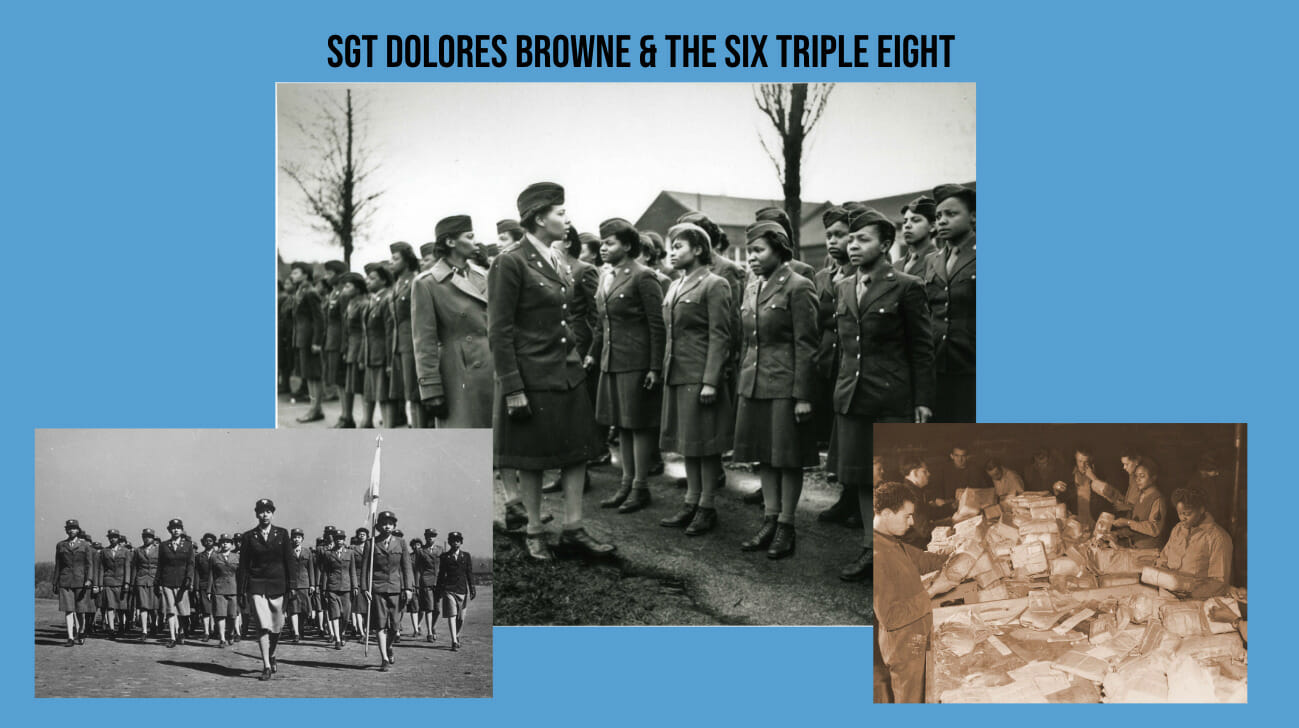
Sgt. Dolores Browne was part of the Six Triple Eight, or the 6888th Central Postal Directory Battalion. The 6888 was the ONLY all-black female unit to serve in Europe during the war. Their mission: to sort through the backlog of army mail that needed to be delivered and sent to and from the front lines in order to maintain morale. Their first stop was London, England. While seemingly unimportant, the 6888 had a huge impact on the war. At the time, there were huge warehouses filled from floor to ceiling with bags of mail, packages, boxes, and supplies. These women sorted 65,000 pieces of mail per shift and around 17 million pieces of mail in total. They completed six months of work in only three months’ time. Sgt. Dolores was one leader of this group. She was 21 when she enlisted. Around a year after D-Day, the 6888 was moved to France to continue their work. It was there in Rowen, France that Sgt. Dolores died after being injured in a jeep accident during the troop’s movement. Because of racist policies at the time, the troop had to pool their own resources for her funeral. She received multiple medals and awards for her service. Although she didn’t necessarily perish during the invasion, her story and the 6888 still represent the total impact the war had and the overall cost of peace
Abby and I [Aanya] received the honor of placing white roses by the graves of two members of the SixTripleEight as well as saying a few words about them and their impact. We fell to tears when honoring these women for they broke norms and barriers by being an active part of war, not only as females but as females of color, setting the stage for our progressive society at present. At the end of the day, their differences did not matter for each and every individual was contributing to the success of the Allies.
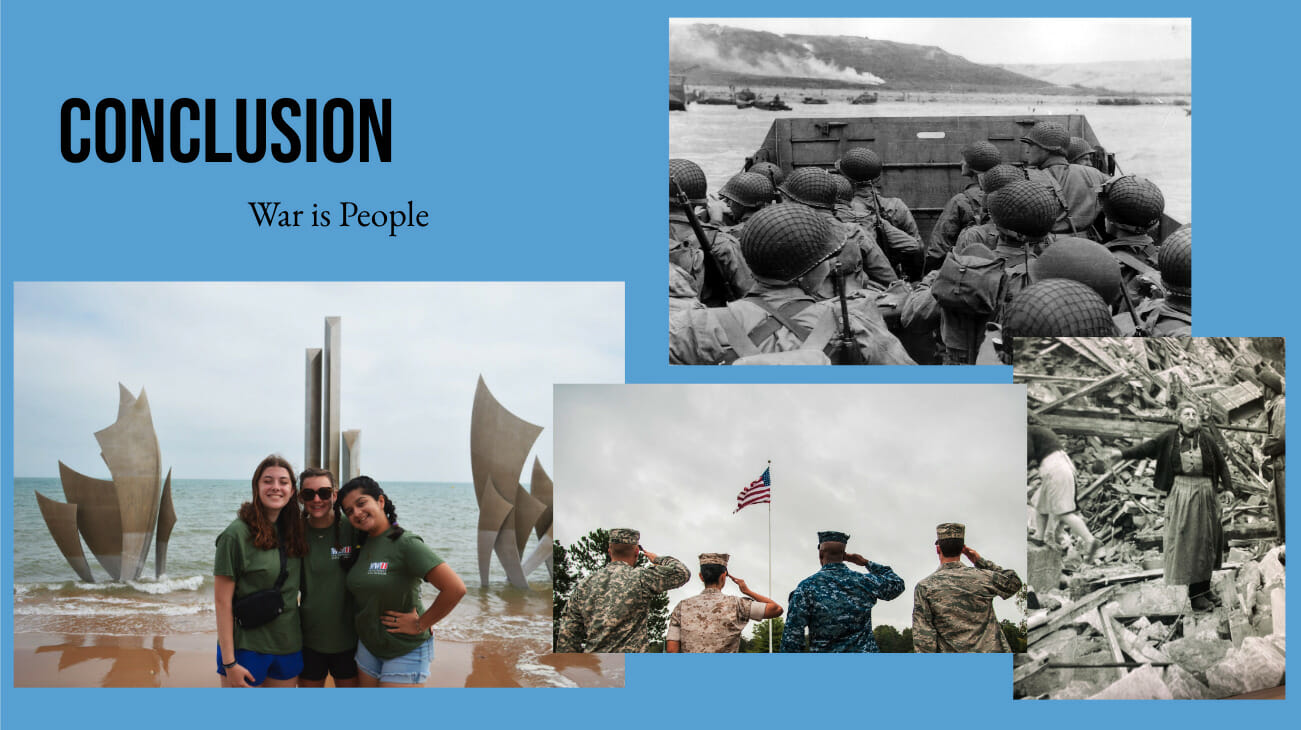
Wars are fought and won by logistics, support personnel, AND those on the front lines. WWII was total war. When considering D-Day, we want you to consider the enormous sacrifices that many soldiers made, the stories of those who were affected by the war, and everyone else that went into the preparation of the assault. Yes, World War II was Sherman tanks, M1 Garand rifles, and Higgins boats. But this war was salutes. This war was people. War is always people. People who died, who lived, those who are honored in cemeteries, those who are forgotten, those who pass their story down. We think that is the point that we want to emphasize the most.
For more information about Normandy Academy, please visit the Normandy Academy website.
